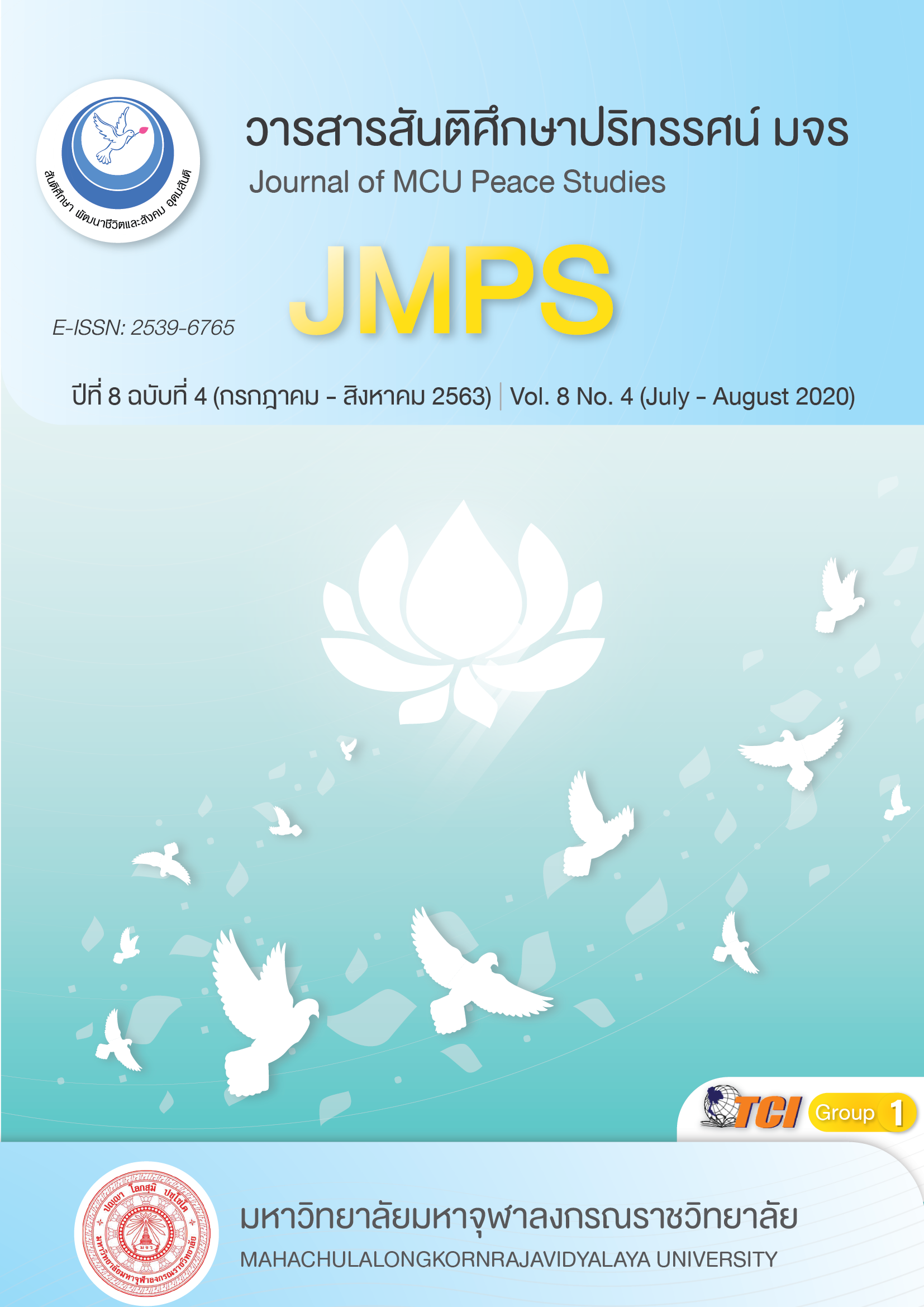บทบาทผู้นำสตรีจิตอาสาเชิงพุทธบูรณาการ
Main Article Content
บทคัดย่อ
สถานการณ์สังคมปัจจุบันกำลังเผชิญกับวิกฤติโรคระบาด ทำให้มนุษย์ต่างดิ้นรนเอาตัวเองให้รอดปลอดภัย คนที่ปรับตัวไม่ทันก็ได้รับผลกระทบทั้งด้านร่างกายและจิตใจ เช่น เกิดภาวะขาดแคลน คนตกงาน ขาดรายได้ สังคมโดดเดี่ยวแยกกันอยู่ ทำให้สังคมเกิดการทอดทิ้งไม่เหลียวแลกัน บทบาทผู้นำสตรีจิตอาสาเชิงพุทธบูรณาการเป็นแนวทางที่สตรีในแต่ละชุมชนได้เขามาช่วยสังคมให้มีทางออก เป็นแสงเงินแสงทอง เป็นความหวัง และเป็นหลักประกันของสังคม ผู้นำสตรีจิตอาสามีแนวทางปฏิบัติเชิงพุทธบูรณาการ กล่าวคือ
1) การทำหน้าที่ด้วยการให้ (ทาน) การแบ่งปันเอื้อเฟื้อเผื่อแผ่ การบริจาคในสิ่งที่ควรให้แก่ผู้ยากไร้ ผู้ที่ขาดแคลน ทั้งในรูปของวัตถุสิ่งของ ให้โอกาส ให้อภัย ให้ความรู้ และคำแนะนำ 2) การทำหน้าที่ด้วยการพูดด้วยวาจาที่อ่อนหวานนุ่มนวล (ปิยะวาจา) พูดจาน่ารัก น่านิยมนับถือ เจรจา อธิบาย ขยายความ เป็น ประโยชน์ เป็นสาระข้อเท็จจริง ประกอบด้วยเหตุผล และความจริงใจ 3) การขวนขวายสร้างประโยชน์ต่อผู้อื่น (อัตถจริยา) การเสียสละแรงกาย แรงใจ และเวลา มุ่งป้องกันควบคู่กับการเสริมสร้างพัฒนา เอาใจใส่ในสุขทุกข์ของอื่นๆ ร่วมแก้ไขปัญหาร่วมกัน ไม่นิ่งดูดายทอดทิ้งกัน 4) การวางตนอย่างเหมาะสม (สมานัตตา) ทำตัวให้เข้ากันได้ ไม่ถือตัว อดทน ร่วมสุขร่วมทุกข์ร่วมกัน
บทบาทหน้าที่ผู้นำสตรีจิตอาสาก่อเกิดคุณค่า เป็นแนวทางที่นำไปสู่การสร้างสิ่งยึดเหนียวเพื่อนมนุษย์ให้รักใคร่ และปรองดองเป็นหนึ่งเดียวกัน เป็นเครื่องผูกใจคน นำพาสังคมให้เกิดสันติสุขโดยรวม สร้างสังคมที่มีคุณภาพชีวิตที่ดี น่าอยู่น่าอาศัย อบอุ่นและปลอดภัย
Article Details
ทัศนะและความคิดเห็นที่ปรากฏในบทความในวารสาร ถือเป็นความรับผิดชอบของผู้เขียนบทความนั้น และไม่ถือเป็นทัศนะและความรับผิดชอบของกองบรรณาธิการ ยินยอมว่าบทความเป็นลิขสิทธิ์ของวารสาร
เอกสารอ้างอิง
Buddhadasa Bhikkhu. (2010). Morals Related to the Youth of the Nation. Bangkok: The Agricultural Co-operative Federation of Thailand Printing Press.
Rodsutti, C. (2004). Administration and Organization Management Column. In Prachachat (Online). Retrieved December 18, 2019, from http://www.trueplookpanya.com/new/cms_detail/knowledge/27586/
Department Of Provincial Administration, Ministry of Interior. (2008). Thailand population statistics. Bangkok: Department of Provincial Administration.
Dokthaisong, B. (1992). Leadership and Leadership Theory. Bangkok: Imprint.
Gibson. J.L., Ivancevich.J.M. & Donnelly. J. H. (1997). Organizations. Behavior. Structure. Processes. (9th Edition). Boston: Mc Graw – Hill.
Himachandra, P. (1978). The Role of Women in Pali Literature. (Master’s thesis). Chulalongkorn University. Bangkok.
Isaranuwatchai, N. (2007). The Desirable Leadership in the Globalization: A Study of the Principles of the Buddha-Dhamma. (Master’s thesis). Graduate School: Mahachulalongkornrajavidyalaya University. Ayutthaya.
Kabilsingh, C. (1994). The Status and Role of Bhikkhuni in Taiwan. Siangtham. Bangkok: Mahachulalongkornrajavidyalaya Printing Press.
King Prajadhipok's Institute. (2008). Women and Politics: Reality, Political Space and Political Drive. Bangkok: Thammada Press.
Mahachulalongkornrajavidyalaya University. (1996). Thai Tipitaka. Bangkok: MCU Press.
Matpho, S. (2006). A Study of Female Administrators' Leadership in Public Universities in Bangkok. (Master’s thesis). Graduate School: Srinakharinwirot University. Bangkok
Meksawan, T. (1994). The Roles of Thai Women in National Development. Workshop Report. Bangkok: Bureaucratic Reform Committee.
Nittayaramphong, S & Smitasiri, S. (1999). Leader. 4th Edition. Bangkok: Phikhanes Printing Center.
Nontakanun, P. (1980). The Concept of Women in Buddhist Philosophy. (Master’s thesis). Chulalongkorn University. Bangkok.
Phrakhru Phisaipariyattikit Aggavaṇṇo. (2010). An Analytical Study of Buddhist Giving Culture in Thai Society. (Master’s thesis). Graduate School: Mahachulalongkornrajavidyalaya University. Ayutthaya.
Phra Brahmagunabhorn (P.A. Payutto). (2004). A Constitution for Living. Bangkok: Religious Printing House, Office of National Buddhism.
Phra Dhammakosajarn (Prayoon Dhammacitto). (2006). Buddhist Management Methods. Bangkok: Mahachulalongkornrajavidyalaya Printing Press.
Prasertsri, R. (2001). Leadership. Bangkok: Thanathud Printing Co., Ltd.
Pruekphongsawalee, M. (2008). Go back Humanity Rights Of women. Office of the National Human Rights Commissionand the Women and Youth Studies Project. Thammasat University.
Royal Society of Thailand. (1982). Royal Institute Dictionary B.E. 2525. Bangkok: Royal Society of Thailand.
Runcharoen, T. (2002). Professional Education Administrators: Potential for Education Reform. Bangkok: Yellow Printing Co.,Ltd.
Sanguankittiphan, T. (2019). Services of Techniques for Counseling Psychology. Retrieved December 18, 2019, from http://www.stou.ac.th/Offices/rdec/udon/upload/Documents/service.doc
Sirimahasakorn, B. (2005). Management to the Leadership Book 1. Bangkok: Teachers Council of Thailand.
Sriboriboon, N. (2007). Development of a Casual Model of Students’ Volunteer Mind in the Upper Secondary Schools Under the Office of the Basic Education Commission. (Master’s thesis). Graduate School: Mahachulalongkornrajavidyalaya University. Ayutthaya.
Stogdill, R.M., (1974). Handbook of Leadership: A Survey of Theory and Research. New York: McGraw-Hill.
Tayakkanon, K. (2000). Leadership Creation Techniques. Bangkok: Rung Wattana Printng House.
Thongtavee, C. (2006, July 30). Contemplative Education Network: From the Small Mind to the Big Mind, Learning in Volunteer Work. Retrieved December 18, 2019, http://jittapanya.blogspot.com/%202006/09/blogpost_115849969911280252.html
Wasi, P. (2007). Rural Development Volunteer: A Case Study of Mahidol University International College Volunteer. Bangkok: Moh-Chao-Ban Publishing House.
Wattana, W., et al. (2000). Future Leaders of Professional Management. Bangkok: Alpha Media Co., Ltd.
Wongput, K. (2002). Leadership. Bangkok: B.K. Interprint Co.,Ltd.


